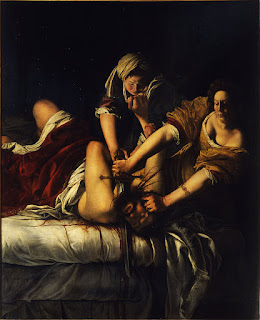Brilliant artist who survived torture by thumbscrews
| Artemisia Gentileschi: a self-portrait as a lute player painted in around 1615-17 |
As a young woman she was raped by an artist friend of her father who had been entrusted with teaching her, and when he was brought to trial by her father she was forced to give evidence under torture.
This event shaped her life and she poured out her horrific experiences into brutal paintings, such as her two versions of Judith Slaying Holofernes.
Gentileschi was notable for pictures of strong and suffering women from myths, allegories, and the Bible. Some of her best known themes are Susanna and the Elders, Judith Slaying Holofernes, the most famous of which, painted between 1614 and 1620, is in the Uffizi in Florence, and Judith and Her Maidservant.
She had an ability to produce convincing depictions of the female figure, anywhere between nude and fully clothed, that few male painters could match.
 |
| Judith Slaying Holfernes (1614-20), which can be found in the Uffizi Gallery in Florence |
Her artist father, Orazio Gentileschi, was an admirer of the painter Caravaggio. He taught his daughter to paint in his interpretation of Caravaggio’s style.
After her father’s friend, the landscape painter Agostino Tassi, raped her, he was brought to trial in 1612 and she had to give evidence while being subjected to a thumbscrew-like torture ‘to make sure her evidence was honest’.
After the trial Gentileschi moved to Florence, married a Florentine and became the first woman to join Florence’s Academy of Design.
Unlike other women artists of the time she specialised in history painting. She painted an Allegory of Inclination for the series of frescoes honouring the life of Michelangelo in Casa Buonarroti.
 |
| Gentileschi's painting San Gennaro nell'Anfiteatro |
Later, she went to London where she worked alongside her father for King Charles I on ceiling paintings for the Queen’s House in Greenwich. She also painted many portraits and eventually became more famous than her father.
It is believed that Artemisia Gentileschi died in Naples during a devastating epidemic of plague that swept the city in 1656.
 |
| The bust of Michelangelo at Casa Buonarroti |
Casa Buonarroti, which Artemisia Gentileschi helped decorate, is now a museum in Via Ghibellina in Florence in a building Michelangelo left to his nephew, Leonardo Buonarroti. The house was converted into a museum dedicated to the artist by his great nephew, Michelangelo Buonarroti the Younger. It houses Michelangelo’s early sculptures and a library with some of Michelangelo’s letters and drawings.
 |
| The interior of the Anfiteatro di Pozzuoli |
Pozzuoli’s Flavian Amphitheatre (Anfiteatro di Pozzuoli) was the third largest Roman amphitheatre in Italy, holding up to 50,000 spectators. Only the Colosseum in Rome and the Capuan Amphitheatre are larger. It was built during the reign of Vespasian by the same architects who previously constructed the Colosseum. Although most of the superstructure has been destroyed in an area subject to frequent seismic activity, the underground interior is still largely intact and well worth a visit. The amphitheatre is in the centre of the town, about 20km (12 miles) west of Naples, close to the Pozzuoli’s Metro station.
More reading:
The mysterious death of Caravaggio
The brilliance of Michelangelo
The rival who broke Michelangelo's nose in a fight
Also on this day:
1822: The death of the poet Shelley in a storm at sea
1918: Ernest Hemingway wounded working for Red Cross in Italy
Home